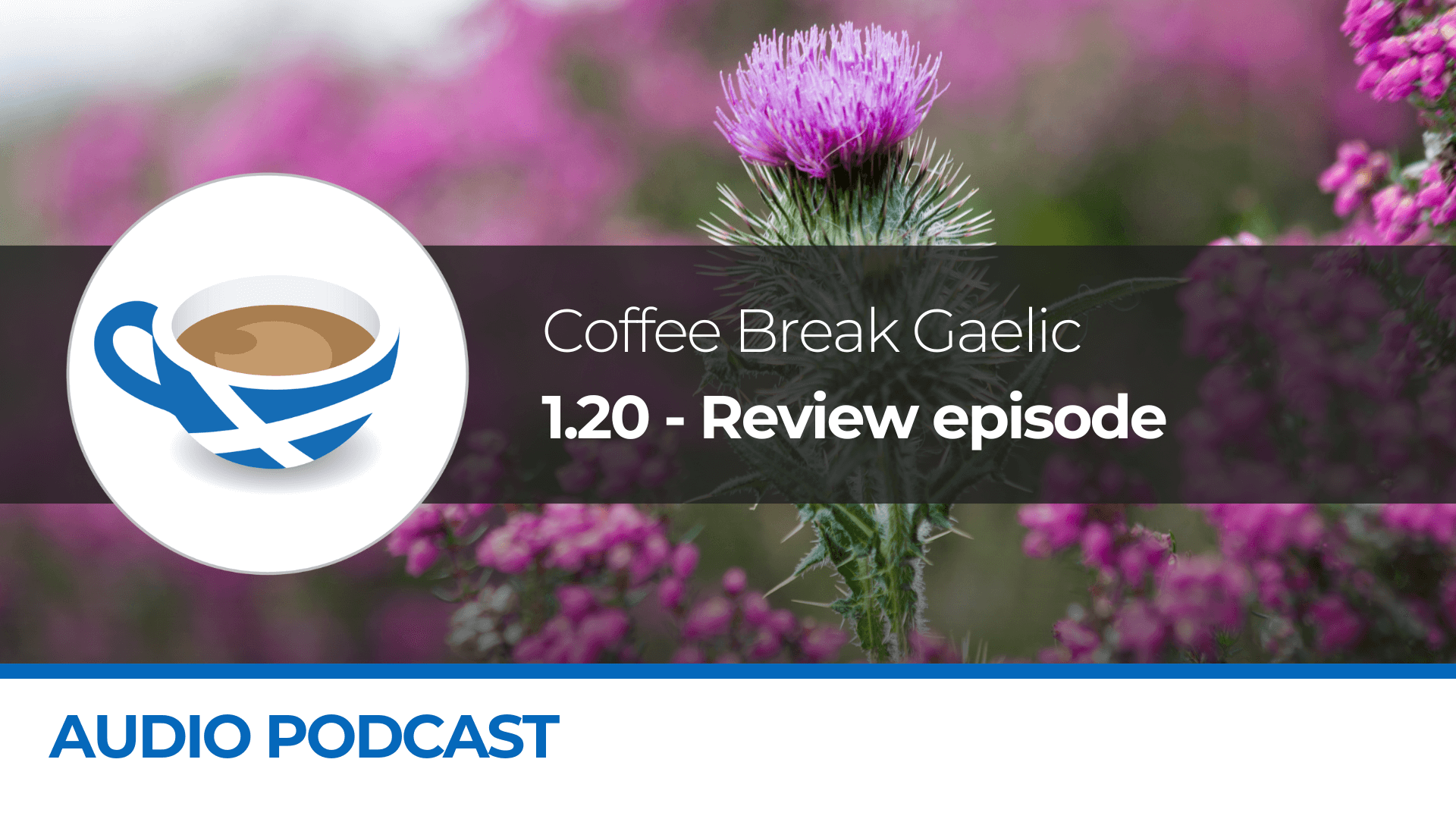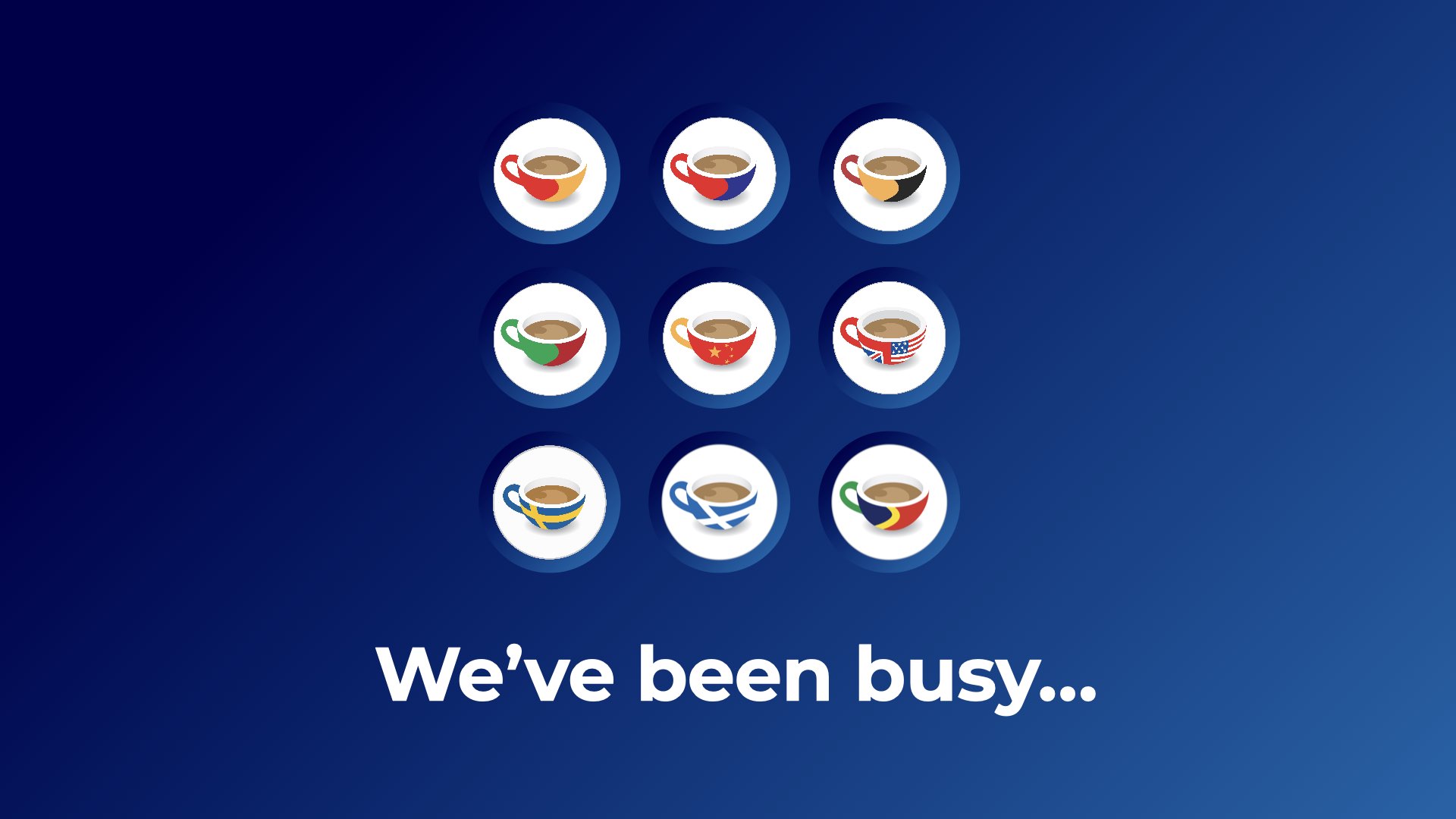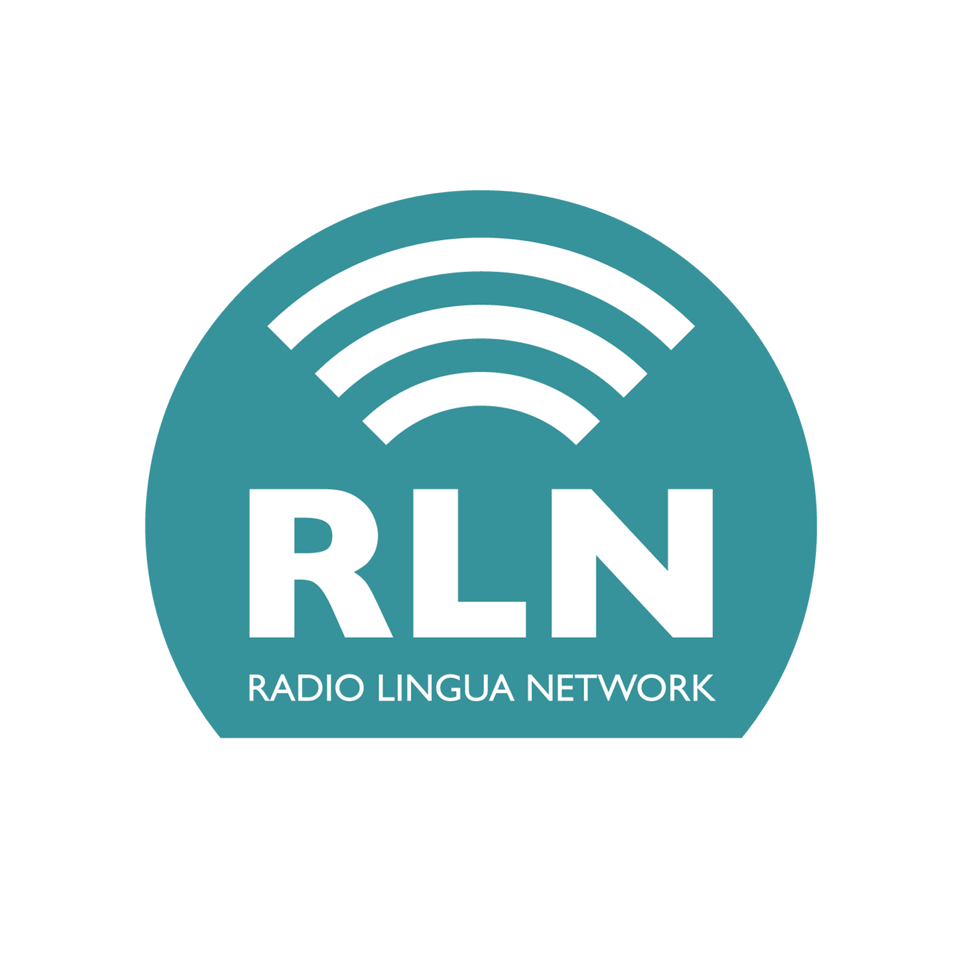Welcome back to another lesson of Coffee Break Gaelic! This time, Susanna and Mark are exploring how to ask the question “why?” in Gaelic. By the end of the lesson, you’ll be able to discuss the reasons why you’re learning Gaelic.
 radiolingua
radiolingua
CBGa 1.26 | Describing people in Gaelic – Eye colour, hair, and other personal features
In this lesson of Coffee Break Gaelic, we’re talking about descriptions so we can describe what people look like. Don’t miss this important lesson!
CBGa 1.25 | Clothes and colours – Talking about what you are wearing
In this lesson, we’re focusing on the topic of clothing and colours. We’ll learn some key vocabulary for items of clothing and how to describe what someone is wearing. This provides the perfect opportunity to revise adjective agreements in Gaelic.
Unlocking the language of loyalty: Coffee Break Dog
In a world where communication transcends barriers, Coffee Break, renowned for its innovative language learning methods, introduces a groundbreaking addition to its repertoire: Coffee Break Dog. This initiative marks a significant leap in understanding and, starting 1st April 2024, will help to bridge the communication gap between humans and their beloved canine companions.
A simple concept
The concept is simple yet profound: to empower individuals with the ability to converse with their dogs in a language they understand. Mark, the founder of Coffee Break, encapsulates the essence of this venture, stating “imagine starting your day not just with your favourite coffee but with a conversation that goes beyond words, reaching out to your furry friend in a language they understand.”
Groundbreaking techniques
At the heart of Coffee Break Dog lies the fusion of Coffee Break’s proven language learning techniques with the pioneering research of renowned dog expert, Flora Lipos. Lipos’ insights into canine behavior and communication serve as the cornerstone for this transformative experience. By applying the Coffee Break methodology to Lipos’ research, learners embark on a journey to decipher the intricate nuances of dog language.
According to Lipos, “Dogs communicate through a complex interplay of vocalizations, body language, and subtle cues. Understanding these signals is key to forging a deeper bond with our canine companions.” This sentiment underscores the significance of Coffee Break Dog in facilitating meaningful connections between humans and dogs.

Curriculum Outline
The curriculum of Coffee Break Dog comprises twenty comprehensive video and audio lessons, meticulously crafted to equip learners with the skills to converse with their pets effectively. From interpreting barks to deciphering different types of tail wagging, each lesson delves into the intricacies of canine communication. What sets this program apart is its interactive nature, encouraging active participation from both learners and their furry counterparts.
As Mark emphasizes, “It’s Coffee Break style for canine communication.” This approach not only makes learning enjoyable but also fosters a sense of camaraderie between humans and their canine companions.
Bone-us content
Furthermore, Coffee Break Dog goes beyond solo learning experiences by offering a special bonus: a partner course tailored specifically for dogs. Through this complementary program, dogs are empowered to understand and respond to human cues, thereby facilitating seamless communication between the two species.
Whether you’re a seasoned dog lover, a devoted pet parent, or simply intrigued by the language of loyalty and love, Coffee Break Dog promises to be your gateway to a whole new world of connection. As Mark aptly puts it, “You’ll no longer be barking up the wrong tree.”
Coffee Break Dog represents a revolutionary approach to fostering communication and understanding between humans and dogs. By amalgamating cutting-edge research with innovative teaching methodologies, this initiative not only enriches the lives of individuals and their pets but also strengthens the bond that transcends species barriers. So why wait? Start learning the language of loyalty with Coffee Break Dog today and embark on a journey of unparalleled connection with your furry companion.
April Fools!
Yes, Coffee Break Dog is, of course, a special announcement for April Fools Day, but we do have 10 other human languages available. Click here to discover your next language today!
CBGa 1.24 | Parts of the body and talking about your health
In Lesson 24 of Coffee Break Gaelic, we’re looking at the topic of health. Language expert Susanna teaches learner Mark the words for different parts of the body and how to describe aches and pains.
CBGa 1.23 | Telling the time in Gaelic and numbers up to twenty
We’re covering a very important topic in Lesson 23 of Coffee Break Gaelic – telling the time! This is a great opportunity to revise Gaelic numbers.
CBGa 1.22 | How to say what you prefer in Gaelic
Now that we know how to talk about our hobbies, we can explore how word order can change when expressing likes and dislikes. We’ll also take this topic a step further and learn how to express preferences in Gaelic.
CBGa 1.21 | How to talk about likes and dislikes and discuss your hobbies
Susanna and Mark are back with another episode of Coffee Break Gaelic! In lesson 21, we’re learning to talk about likes and dislikes in the language. By the end of this lesson, you’ll be able to discuss your hobbies with your Gaelic-speaking friends.
CBP 1.21 | The weather – How to talk about the weather in Portuguese
Welcome back to another lesson of Coffee Break Portuguese! We’re now halfway through our 40-lesson course and in lesson 21 we are talking about the weather. We’ll be learning how to ask what the weather is like today and what it is going to be like tomorrow, how to answer these questions to describe various types of weather, and hear a weather forecast for Portugal in today’s Cafezinho com Catarina. We’ll also have a more in-depth look at one particular aspect of Portuguese grammar – the difference between the verbs ser and estar, which both translate as “to be”. Vamos lá!
CBGa 1.20 | End-of-unit review – The basics in Gaelic from Lessons 1–19
Let’s put everything we’ve learned so far to the test in this special episode marking the end of the first half of our Coffee Break Gaelic course! Listen to an extended conversation featuring key vocabulary covered over the past 19 lessons. We’ll be back soon with lesson 21!
CBP 1.20 | End-of-unit review – The basics in Portuguese from Lessons 1–19
We’ve reached lesson 20 of Coffee Break Portuguese, which marks the halfway point in our beginners’ course. In this episode we’re reviewing what we’ve learned throughout the first 19 lessons. We’ll be doing this by listening to a dialogue that incorporates many of the topics we’ve covered so far. We hope you enjoy seeing how much you’ve learned over the past 19 lessons and we’ll be back soon with lesson 21!
CBGa 1.19 | Offering drinks in Gaelic
In this episode, we’re moving on to the topic of drinks so you can enjoy a Gaelic coffee break! You’ll learn the words for different types of drinks in Gaelic and how to ask and answer the question “what do you want?”
CBP 1.19 | Travelling by public transport
This lesson of Coffee Break Portuguese is all about travel. Join Rafael and Ava to learn the phrases you need to know when dealing with travel situations in a Portuguese-speaking country, including using public transport and buying travel tickets. We’ll also listen to a practice dialogue set in a train station and hear from Catarina in today’s Cafezinho com Catarina, in which she tells us a little more about the Azores.
CBGa 1.18 | What are you doing? – How to talk about what you are doing in Gaelic
Welcome back to another lesson of Coffee Break Gaelic! This time, Susanna and Mark are focusing on how to ask “what are you doing?” in Gaelic. By the end of this lesson, you’ll not only know how to ask this question, you’ll also be able to provide a range of answers. You’ll be one step closer to becoming a fluent Gaelic speaker!
CBP 1.18 | Understanding and giving directions – How to give directions in Portuguese
Welcome to lesson 18 of Coffee Break Portuguese! In this lesson we are talking about how to ask for directions and how to give directions in town. If you haven’t already listened to episode 8 of our course, we would recommend finding it wherever you’re listening to this episode, as we’ll be expanding on what we learned in that lesson. Vamos lá!
When to use ‘do’ and ‘make’ in English
Do you know when to use do and when to use make when you’re speaking English? This can be a difficult topic for English learners, because many languages just have one verb for do and make. In this episode of The Coffee Break English Show, we’ll do some work to help you avoid making mistakes with do and make.
The Coffee Break English Show is a podcast series of informal conversations to help you understand some difficult topics in English! In the latest episode, Josie and Mark talk about when to use do and make.
There are some rules to follow, but as Josie and Mark explain during the episode, the best way to learn when to use do and make is to learn some fixed expressions.
So, let’s get started and look at the rules and expressions with do and make. Continue reading to find out more, and why not listen to the podcast as you go!
Make
We use make when we create or produce something. The result is usually something that we can see and touch. Here are some examples:
make dinner
I’m making pasta for dinner tonight.
make lunch
Mark made a salad for lunch.
make breakfast
My grandma makes pancakes for breakfast on Sundays.
make a coffee
Would you like me to make you a coffee?
make clothes
My brother makes his own clothes – he’s very creative.
make furniture
I made this table all by myself.
Do
We use do to describe actions. Let’s look at some examples:
do homework
The children are doing their homework.
do housework (e.g. do the laundry, do the dishes)
I don’t like doing housework.
do something
I’m bored – let’s do something fun!
do anything
Did you do anything yesterday evening?
do nothing
He loves doing nothing on Sunday mornings.
Fixed expressions with ‘make’
As we mentioned before, the best way to learn when to use make and do is to learn some fixed expressions. Here are five fixed expressions with make:
make a mistake
When you’re learning a language, you often make mistakes.
make friends
I made all my best friends at university.
make a decision
We need to make a decision about where to go on holiday this summer.
make plans
Have you made plans for the weekend yet?
make a mess
Please try not to make a mess in the kitchen!
Fixed expressions with ‘do’
Now you’ve seen some expressions with make, here are five fixed expressions with do:
do your hair / make-up
It usually takes her 10 minutes to do her hair in the morning.
do an exam
I did an exam yesterday, and I passed!
do exercise / sport
Do you usually do exercise in the morning or in the evening?
do the shopping
I’m going to the supermarket to do the shopping.
do research
She is doing research for her PhD at the moment.
Remember, there are many more expressions with make and do. It’s a good idea to make a list when you see or hear a new expression, to help you remember it.
Let’s review

If you found this post interesting, make sure you listen to the full podcast episode with Mark and Josie on The Coffee Break English Show. We will release more episodes soon, about some more useful topics! Subscribe to our podcast feed and our channel on YouTube to learn when the next episode is available.
Plus! To get regular free English lessons in your inbox, you can sign up for our email lessons. We regularly send short (coffee-break-sized) email lessons that will help you improve your English. You will also hear from Mark, the founder of Coffee Break Languages, giving advice for language learners at any level. Sign up below!
So, keep practising make and do! Remember that all English learners make mistakes, but people can usually still understand you. It’s all part of the language-learning journey. Why not make a coffee now and do some more research about make and do?
Happy Coffee Breaking!
Listen to the podcast
Converse in Italian like a native: choosing ‘tu’ or ‘Lei’
When you speak Italian, formality is more than just a grammatical nuance – it’s a cultural code that reflects our relationships and social contexts.
The Coffee Break Italian Show is a podcast series of bite-sized, friendly conversations in which we demystify tricky Italian language topics. In the latest episode, Mark and Francesca delve into the fascinating world of Italian formality and how to address people, choosing between tu and Lei.
This can be difficult at times, but don’t worry! Francesca and Mark share some tips – whether you want to talk to a friend, a relative, a doctor, or even the president of Italy.
Continue reading to find out more, and why not enjoy the podcast episode as you go?
Formality in Italian
Formality, in the context of the Italian language, hinges on the choice between tu and Lei – the two ways of addressing someone as “you”. This affects not just pronouns but verb conjugations as well, and choosing between tu and Lei involves recognising the nature of the situation and whether it is most appropriate to sound informal or formal.
In terms of which form of the verb to use:
tu is used in the second person singular form of the verb, for example tu canti (“you (informal) sing”), tu apri (“you (informal) open”)
Lei is used in the third person singular form of the verb, for example Lei canta (“you (formal) sing”), Lei apre (“you (formal) open”)
You might notice that Lei shares its written form with the third person singular pronoun lei (“she”), however it starts with a capital letter.
The plural you
The plural form of address is voi for both informal and formal contexts. For example:
Bambini, volete del gelato?
Children, would you like some ice cream?
Come posso aiutarvi, signori?
How can I help you, gentlemen?
A very formal plural form of address, Loro, is usually reserved for extremely formal situations, such as high-end establishments like luxury hotels.
Loro sono i signori Verdi?
Are you Mr and Mrs Verdi?
Loro voglio accomodarsi?
Would you like to take a seat?
Decoding the scenarios
-
Strangers
Imagine you’re meeting someone for the first time or you’re asking someone for information. In this case, the safer option is to use the formal form of address, Lei, unless the person is noticeably younger than you. Let’s say you want to catch their attention – you would say:
Scusi!
Excuse me! (formal)Scusa!
Excuse me! (informal)
-
Professional settings
At workplaces or when addressing superiors, such as your boss, adopting the formal Lei is the norm. Similarly, in academic settings like schools and universities, people tend to use formal language when communicating with teachers and professors.
-
Familiar territory
Among friends and people you know well, the informal tu is the way to go. It conveys a sense of intimacy and familiarity.
Titles as indicators of formality
Formality often comes hand in hand with titles. Adding titles can be a clear sign of formality, for example:
Signore / Signora
Sir / Madam or Mr / Ms
Professore / Professoressa
Professor
Dottore / Dottoressa
Doctor
These titles show respect and set the tone for a formal conversation.
When to transition to ‘tu’
Sometimes, negotiating formality becomes an explicit conversation. The following phrases are all ways of transitioning to a more familiar or relaxed tone of conversation.
diamoci del tu
let’s use the tu form with each other (literally, “let’s give each other the tu form”)
dammi del tu
use the tu form with me (literally, “give me the tu form”)
non darmi del Lei
don’t use the Lei form with me (literally, “don’t give me the Lei form”)
Choosing between tu and Lei is a personal decision that, once made, tends to be stuck to within a conversation or even relationship (unless a transition like this happens).
Note that, while nowadays it is possible to notice a shift towards informality, the majority of Italians still prefer to use both tu and Lei, depending on the situation.
Regional variants
Sometimes geography plays a role in the choice of forms of address. In southern Italy, the tendency to replace Lei with voi is noticeable, echoing the French vous. For example:
Signor Turri, volete un caffè?
Mr Turri, would you like a coffee?
È tutto, signore e signori!
The choice between tu and Lei in Italian is more than just grammatical – it is also about social customs. Understanding these subtleties enables you to navigate various situations, whether chatting with friends, addressing your boss, or exploring the charming streets of Italy.
If you found this post interesting, make sure to listen to the full episode with Mark and Francesca on The Coffee Break Italian Show. This is the series in which we look at a range of topics for Italian learners, so make sure to subscribe to our podcast feed or our channel on YouTube.
Plus! To get regular free Italian lessons in your inbox, you can sign up for our short (coffee-break-sized) email lessons that will help you improve your Italian. You will also hear from Mark, the founder of Coffee Break Languages, giving advice for language learners at any level. Sign up below!
If you have conversations in Italian, the choice between tu and Lei is bound to come up sooner, rather than later. The best tip is not to stress about it. People will understand you are a learner, and the advice in this blog will give you a firm starting block.
Happy Coffee Breaking!
Listen to the podcast
CBP 1.00 | Introducing Coffee Break Portuguese
In this short introductory episode of Coffee Break Portuguese, teacher Rafael and learner Ava explain what’s to come in this series for beginners in Portuguese. We hear more about the types of topics that will be covered to help us when travelling to a place where Portuguese is spoken. We also get to know more about Rafael, Ava and Catarina and their language-learning backgrounds before learning about the term ‘Cafezinho’ and how this will be incorporated into our lessons.
New podcasts, new courses, a new platform and a new app!
Coffee Break Swedish Travel Diaries
Coffee Break Chinese Characters
Il était une fois
 Our new French audio and video course for advanced learners takes the form of a game show. Max and Pierre-Benoît challenge each other to write a story against the clock, and the course provides a transcript, video with subtitles and language development resources. Watch the demo video here.
Our new French audio and video course for advanced learners takes the form of a game show. Max and Pierre-Benoît challenge each other to write a story against the clock, and the course provides a transcript, video with subtitles and language development resources. Watch the demo video here.
Coffee Break Spanish Season 5 – La penúltima voluntad
Advanced learners can start following the story of Marta who has just been asked to attend the reading of her father’s will. In the 20 chapters of the story you’ll build your confidence in advanced Spanish. Click here for more information.
Coffee Break Gaelic
 We’ll be launching a new course in Gaelic in 2023. Learn the basics of Scottish Gaelic with Susanna and Mark. This course will feature 40 lessons and will follow the structure of our previous Coffee Break courses. Find out more here.
We’ll be launching a new course in Gaelic in 2023. Learn the basics of Scottish Gaelic with Susanna and Mark. This course will feature 40 lessons and will follow the structure of our previous Coffee Break courses. Find out more here.
Coffee Break Portuguese
Another new member of the Coffee Break family is our new course in Portuguese. You’ll learn to communicate with Portuguese speakers from around the world in our course, starting January 2023. Get a sneak preview and find out more here.
Coffee Break TV
We hope you’re as excited as we are about these announcements and that you’ll have all the more opportunity to build your language skills on your Coffee Break!
CBI 3.01 | Direct object pronouns – Una vacanza studio a Siena
In this first episode of Coffee Break Italian Season 3, Francesca and Mark explain how Direct Object Pronouns work with simple verbs in the present tense. You’ll hear an explanation of the grammar point, then listen to a dialogue in which John, a Scottish student of Italian, is in Siena to improve his language skills. He has a chat with his teacher of Italian about his language learning experience.
If you’d like to take advantage of bonus materials, lesson notes and a translation challenge, you can access the full Coffee Break Italian Season 3 course on the Coffee Break Academy.


























